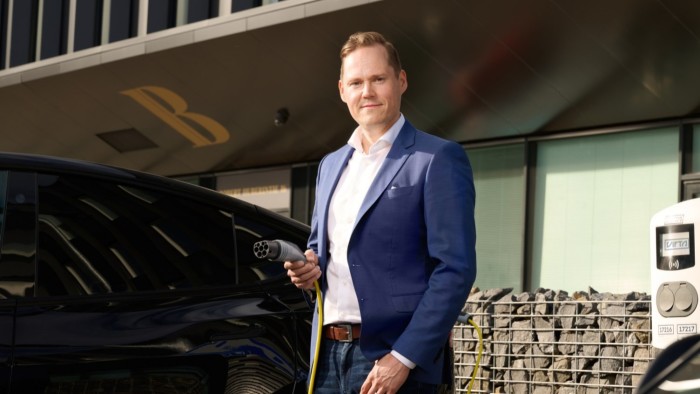From broadband internet and mobile phones to cash-free societies, digital government and cloud computing, Nordic countries’ early adoption of innovations has often given their companies a head start.
The quick response that helped Nokia, Skype, Spotify and Klarna dominate their industries is now benefiting Nordic companies in emerging fields such as electric vehicle (EV) charging and cloud software.
“Once you are an early starter in this industry . . . you have an advantage,” says Benny Guttman, senior partner at the consultancy Roland Berger, of the EV charging market.
Norway has been the global leader in the transition to EVs since 2013, when the Tesla Model S was the best-selling car, surpassing petrol rivals. Last year, 89 per cent of new car sales in Norway were pure electric, while in Denmark the figure was 52 per cent. In Sweden, 32 per cent of sales were electric, and 58 per cent with plug-in hybrids, while in Finland the figures were 29 per cent and 69 per cent.
Kempower, a Finnish charging hardware company which is eighth in the FT1000 ranking of Europe’s Fastest Growing Companies, and Virta (ranked 283rd), a Finnish company which focuses on charging software and payment solutions, have both benefited from the early rollout of EV charging networks in the region.
“Nordic countries have been [among] the most advanced players in incentivising this transition and this has brought the technologies forward, and then the market,” says Jussi Palola, chief innovation officer and co-founder at Virta.
He also credits the Finnish government for launching a €110mn project to fund research on EV charging systems in 2011, which led to the creation of Virta and Kempower. “The logic from the Finnish perspective was that this transition is essential, it is going to happen, and we want to lead the technologies in this area,” Palola says.
Company purchases of electric vehicles for employees, encouraged by tax incentives, helped spur the development of the market in Sweden, with the EV share of company purchases growing from 16 per cent in 2018 to 74 per cent in 2023.
The high-profile collapse of Swedish battery maker Northvolt sent shockwaves through the renewables sector. But Guttman dismisses fears of a backlash after recent US policy shifts.
Nordic companies have shown a similar openness to innovation when adopting software solutions to make processes such as hiring, accounting, marketing and sales more efficient.
“The level of digitisation and the openness towards digitisation is just next level,” says Milos Lørup Bartosek, an Oslo-based director at the consultancy Strategy&, part of PwC. “This openness comes down to the level of trust, transparency and positive experience with digitisation in each of the Nordic countries, which is much higher than we observe . . . in the UK and Germany.”
This openness has helped power the rapid growth of companies such as Sweden’s Teamtailor and Funnel, Norway’s Omnium, and Finland’s Epassi, which help companies with recruitment, sales, order management and employee benefits respectively. Of the 42 Nordic companies in the ranking, 12 offer some kind of cloud-based subscription software service to other businesses.
“They’re not necessarily the next Microsoft, but they find very strong niches in which you can build businesses with revenues in the hundreds of millions of euros”, Bartosek says of the business-to-business software-as-a-service or “B2B SaaS” sector.
The key, as outlined in a Strategy& Nordic sector report, has been providing “an incredibly strong value proposition” to customers, especially in the small and medium sized business segment. This helps them to carry out key functions better with fewer staff, so that savings and improved performance more than cover the cost of subscription.
Trust also fosters co-operation between Nordic companies. Virta has made KemPower a preferred hardware partner and the SaaS companies offer integrations with dozens of other similar businesses, both Nordic and international.
“Nordic companies tend to collaborate,” Guttman says, noting that “there are clear benefits to being Nordic in another Nordic country”.
As well as a receptive regional customer base, the region also has hubs and incubators for start-ups, seed capital from government agencies and angel investors, and growth capital from investors such as Sweden’s Creandum, Norway’s Verdane, and Denmark’s ByFounders.
Most of these companies have continued to grow despite a slowdown in Nordic economies in recent years. GDP in Finland and Sweden shrank by 1.2 and 0.3 per cent respectively in 2023, while that of Norway, excluding oil and gas, grew by 0.5 per cent. While there were signs of recovery in 2024, growth remains weak, with Sweden’s and mainland Norway’s economies growing by 1 per cent and 0.6 per cent respectively, while Finland’s shrank by 0.5 per cent.
Denmark’s economy has been the exception, with GDP growth of 2.5 per cent in 2023 and 3.2 per cent in 2024, thanks partly to the success of Novo Nordisk’s obesity drug Wegovy.
The B2B SaaS companies have been resilient primarily because most offer ways for their customers to cut costs. The shift to EVs, meanwhile, is continuing, despite the economic slowdown and the removal of subsidies.
“Of course, the global economic turmoil has slowed down some markets,” says Palola. But he predicts revenue growth this year, with Europe’s EV fleet to increase by 20 to 25 per cent.
A bigger threat is competition. Advanced AI companies now threaten B2B SaaS by fully automating tasks such businesses had only helped clients to do more efficiently.
“The big question for every B2B SaaS company is how it will be able to integrate itself into the AI ecosystem, and how to develop its own agents using AI,” Bartosek says.
Vehicle-charging companies, meanwhile, face competition from lower cost Chinese rivals and larger European and US companies.
“It’s going to be a little bit tougher going forward for these companies, especially those that don’t have positive cash flows,” Guttman says. “Some will go out of business, some will be bought up, and some will thrive.”
Read the full article here

